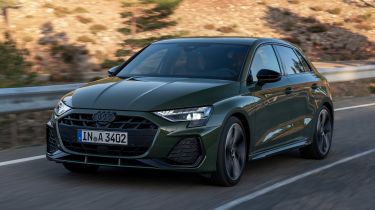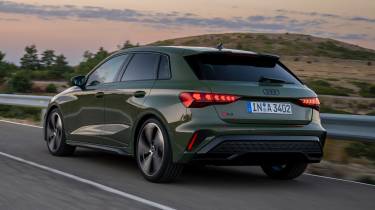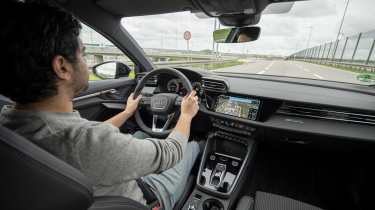New Audi A3 facelift 2024 review: big improvements for the premium hatch
The updated Audi A3 hasn’t been revolutionised, but is thoroughly improved thanks to a set of small but impactful improvements

Verdict
The refreshed Audi A3 offers a compelling combination of efficient and refined powertrains, sharp styling, good tech, and improved build quality. In fact, it’s this final element that really elevates it above the mainstream competition – putting it right back in the fight against rivals from Mercedes and BMW.
The Audi A3 has long found favour with buyers here in the UK thanks to its slick styling, high-quality interior, decent tech and premium image. Yet while the latest-generation car is certainly popular, it hasn’t always embodied those elements – something Audi’s hoping to remedy with a mid-life update.
Changes for the new A3 include a streamlined exterior design with new lighting elements, colour and trim options, plus a subtly refreshed interior and tech package. But while these may seem inconsequential, they add up to a marked difference. There are less on-paper changes under the skin as most powertrain and chassis elements have been left alone, but there have been a few subtle tweaks to the tuning and software.
At first, Audi will launch the A3 Sportback and saloon in the UK with a pair of four-cylinder ‘35’ petrol and diesel engines, plus the hot S3. An entry-level three-cylinder, a petrol plug-in hybrid, plus higher-powered four-cylinder models are due to arrive later this year. For now though, we’re driving the predicted best seller – at least until that PHEV turns up in time.
Used - available now
Inherently, this powertrain is smooth, refined and impressively efficient. The 148bhp 1.5-litre petrol engine comes with a standard mild-hybrid system and seven-speed dual-clutch transmission, which work together to keep the engine in its most effective powerband. It’s happiest at around 2,000rpm, surfing on its restrained but effective 250Nm of torque. Official fuel consumption stands at 50.4mpg, which looks to be an achievable figure in the real world – we averaged around 48mpg on fast German A-roads and a bit of Autobahn.
That mild-hybrid system allows for lots of engine-off coasting, ensuring the motor is only running when absolutely necessary. Like a lot of these set-ups, it uses regenerative braking to recuperate energy and put it back into the tiny lithium-ion battery.
As a result, as you come up to a junction or if there’s traffic ahead, it’ll often re-ignite the engine and apply some regen automatically which some, us included, may find a little disconcerting. You can switch this off, though.
The rest of the driving experience is good, with accurate steering that’s nicely weighted and a ride quality that was firm, but well damped – even on our car’s reasonably sized 18-inch wheels. Overall refinement is also very good, with little road or wind noise entering the cabin. When you do push on a bit the chassis feels capable and trustworthy, just don’t go expecting a thrilling hot-hatchback-like driving experience.
There are other, more tangible benefits to this new A3 and they largely concern the cabin. When the current-generation model was launched, its new design was let down by poor material quality in places – made worse by the fact its predecessor set such a high benchmark in the class. While this new model doesn’t have any major structural changes inside, the materials have been upgraded where possible, giving the whole cabin a much more premium feel.
Our S line model featured a set of brilliant seats with contrasting stitching, plus a dashboard now lined in a textured fabric that brings some much needed interest to the cabin. Other tiny details like the new air-vent internals and redesigned materials also make a difference, adding up to a genuine all-round improvement.
The cabin’s interior lighting has also been given an upgrade, with a new system of brighter LEDs and laser-cut fabric panels that shine light from within. These elements don’t fundamentally change how the cabin looks or feels in daytime driving, but make it feel more premium at night. The new matrix LED headlights are also worth a mention, as you can now configure your own lighting signature from four options.
Audi hasn’t changed any of the technology interfaces, as it still combines a 10.1-inch touchscreen infotainment system with a 12.3-inch Virtual Cockpit driver’s display. This combination might not have the legs in terms of outright screen size – VW’s new 15-inch option in the updated Volkswagen Golf takes that crown – but the embedded system works really well, and comes with a set of physical air-conditioning controls.
The MMI Touch software itself is also good, with clean graphics and a simple menu structure. All the on-board systems work well, with accurate traffic information for the navigation. Wireless Apple CarPlay and wired Android Auto are standard-fit, and integrate well with the touchscreen – plus those separate AC controls mean you never need to exit the phone-mirroring systems to change the temperature or fan speed.
It’s also reasonably practical, with more space in the second row than a Mercedes A-Class and BMW 1 Series, plus a 380-litre boot. That’s on-par with the BMW and slightly bigger than the Merc, but is more accessible thanks to a larger tailgate and lower load-lip.
| Model: | Audi A3 Sportback S Line 35 TFSI |
| Price from: | £34,315 |
| Engine: | 1.5-litre 4cyl turbo petrol, MHEV |
| Power/torque: | 148bhp/250Nm |
| Transmission: | Seven-speed automatic, front-wheel drive |
| 0-62mph | 8.4 seconds |
| Top speed: | 127mph |
| Economy/CO2: | 50.4mpg/127g/km |
| Size (L/W/H): | 4,343/1,816/1,449 |
| On sale: | Now |













